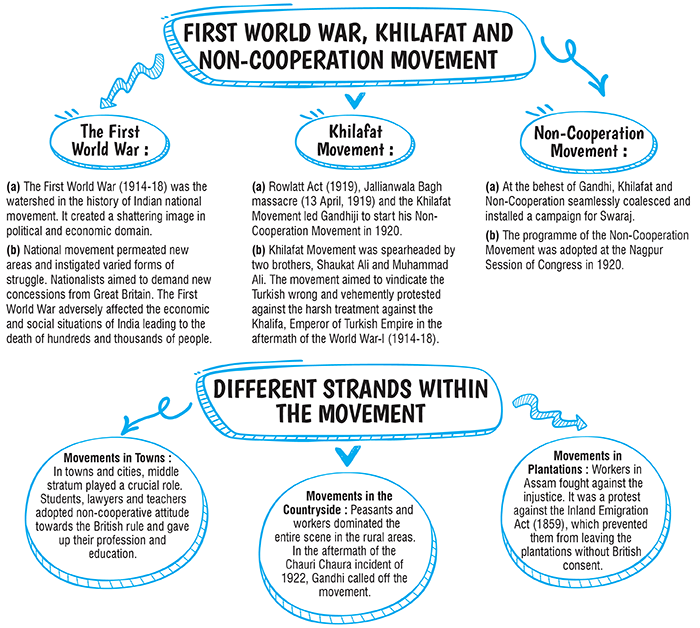Nationalism In India Class 10 Notes History Chapter 2
What are Nationalism in India?
The dot mark ◉ field are mandatory, So please fill them in carefully
To download the complete Syllabus (PDF File), Please fill & submit the form below.
To download the complete Syllabus (PDF File), Please fill & submit the form below.
https://drive.google.com/file/d/1EVQ8pCfzjsTQ0XWAPzS1hiUeUWj0sKFw/view

Towards civil disobediencethe
Swaraj Party :
- (a) C.R. Das and Motilal Nehru established the Swaraj Party within the Congress. The Simon Commission (1928) arrived in India.
- (b) At the Lahore Session of the Congress (Dec. 1929), the Congress adopted the resolution of Complete Swaraj as itsgoal. 26th January, 1930 was celebrated as the Independence Day.
Famous Dandi March :
(a) Famous Dandi March began on March 12, 1930. On 6th April, 1930 Gandhiji reached Dandi, a village in Gujarat and broke the Salt Law by boiling water and manufacturing salt. Thus, began the Civil Disobedience Movement.
- The Non-Cooperation Movement (1920-22) attempted to bring the government to a standstill by non-cooperating with the administration.
- The Civil Disobedience Movement aimed at paralyzing the government by performing illegal acts.
- Boycott of foreign goods, non-payment of taxes, breaking forest laws were its main features.
- The British Government followed a policy of brutal repression. It arrested all the leaders including Gandhiji and Nehru. Nearly 1,00,000 people were arrested.
- Lord Irwin, the Viceroy, signed a pact with Gandhiji on 5 March, 1931. Gandhiji agreed to attend the Second Round Table Conference and the British agreed to release all the political prisoners.
- Gandhiji returned disappointed from the Second Round Table Conference in December 1931. Civil Disobedience movement was started again.

| 1. Satyagraha: Satyagraha loosely construed as ‘emphasis on truth’, ‘allegiance to the truth’ or ‘truth force’. It is a particular variant of non-violent resistance or civil resistance. The term Satyagraha was concocted by Mahatma Gandhi. He aimed to implement Satyagraha in the context of Indian Independence Movement and also during his earlier struggles in South Africa for the Indians’ rights. | 7. Martial Law: Martial Law indicates the impose of direct military control of normal civilian functions of government, particularly in relation to a temporary emergency like intrusion or major disaster in an occupied region. |
| 2. Picket: A strand of protest or demonstration by which people block the entrance to a shop, factory or office. Dayanand Saraswati and subsequently developed by Mahatma Gandhi. However, the word ‘Swaraj’ actually means Gandhiji’s concept for Indian Independence from foreign exploitation. | 8. Guerrilla Movement: This movement generally related to irregular warfare in which small group of combatants. Such as armed civilian, paramilitary personnel use military tactics which includes raids, hit and run tactics etc., to fight a larger and less mobile conventional military. |
| 3. Begar: Labour that the villagers were compelled to render his/her service to the ‘master’ free of charge or at a nominal remuneration. | 9. Forced recruitment : It is a system by which the colonial state compelled people to join the army. |
| 4. Boycott: It is an act of refusal to busy, use or participate, it is way of protesting. | 10. Civil Disobedience Movement: Civil disobedience is the active, professed denial of a citizen to follow certain rules and laws of the state, orders and commands of a government. Civil disobedience is tantamount to non-violent or passive resistance. Mahatma Gandhi ji initiated the civil disobedience against the aggressive British rule in the nation. |
| 5. Nationalism: Nationalism is an ideology and movement that promotes the interests of particular nation, with the aim of gaining and maintaining the nation’s sovereignty over its home land. | 11. Rowlatt Act: The Anarchical and Revolutionary Crimes Act of 1919 was popularly regarded as the Rowlatt Act. Rowlatt Act gave power to the police to arrest any person without any reason. The purpose of the Act was to curb the growing nationalist upsurge in the country. |
| 6. Swaraj: Swaraj means self-governance or ‘self-rule’. It is tantamount to ‘home-rule’ coined by Swami Dayanand Saraswati and subsequently developed by Mahatma Gandhi. However, the word ‘Swaraj’ actually means Gandhiji’s concept for Indian Independence from foreign exploitation. | |